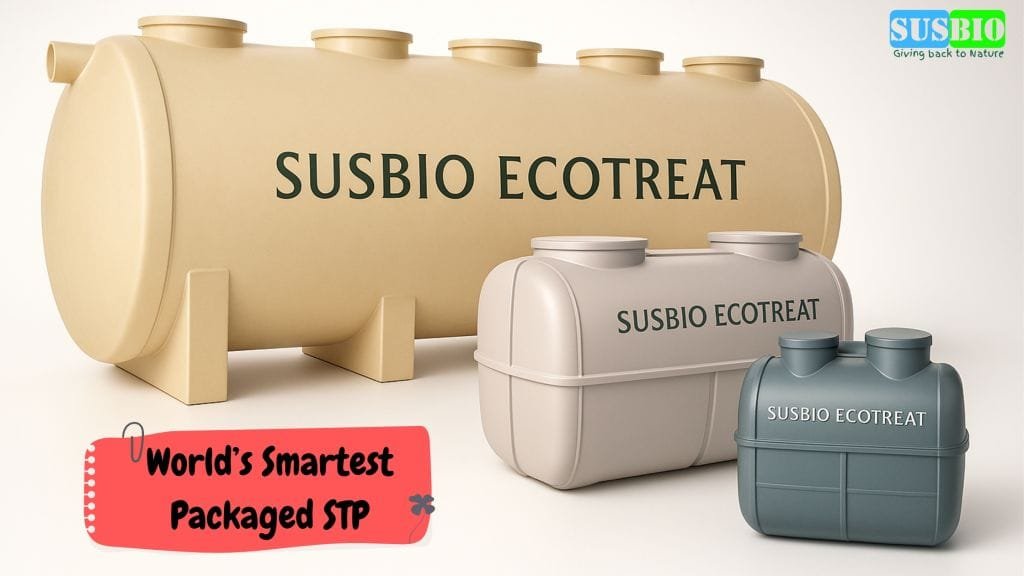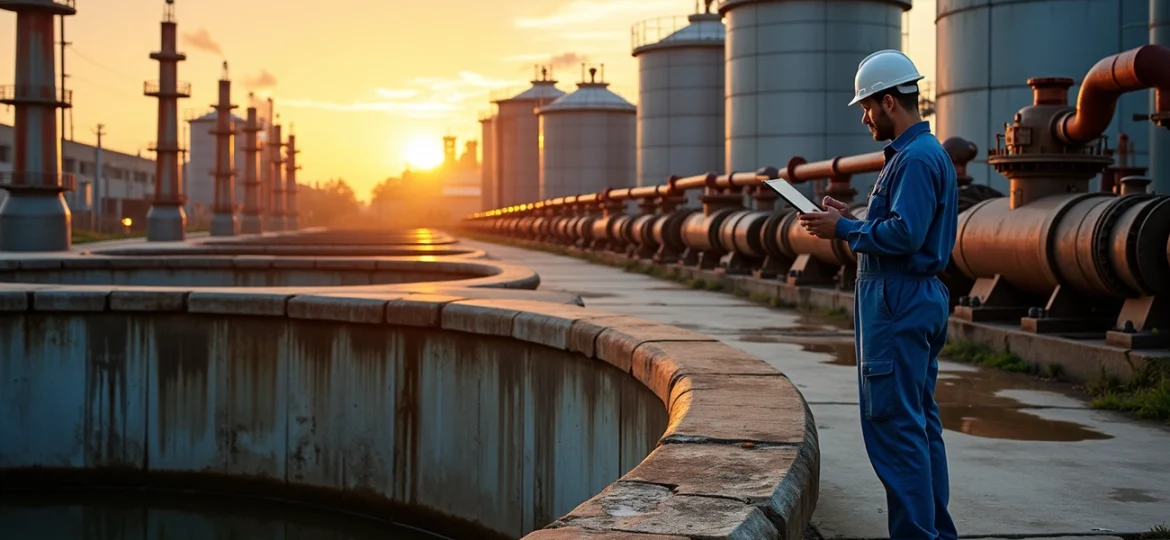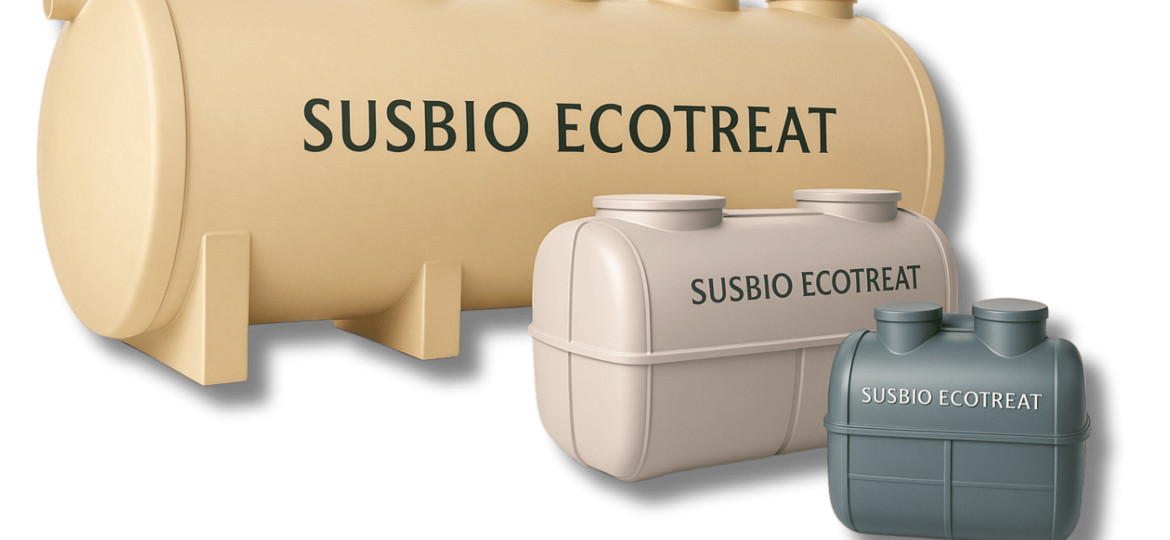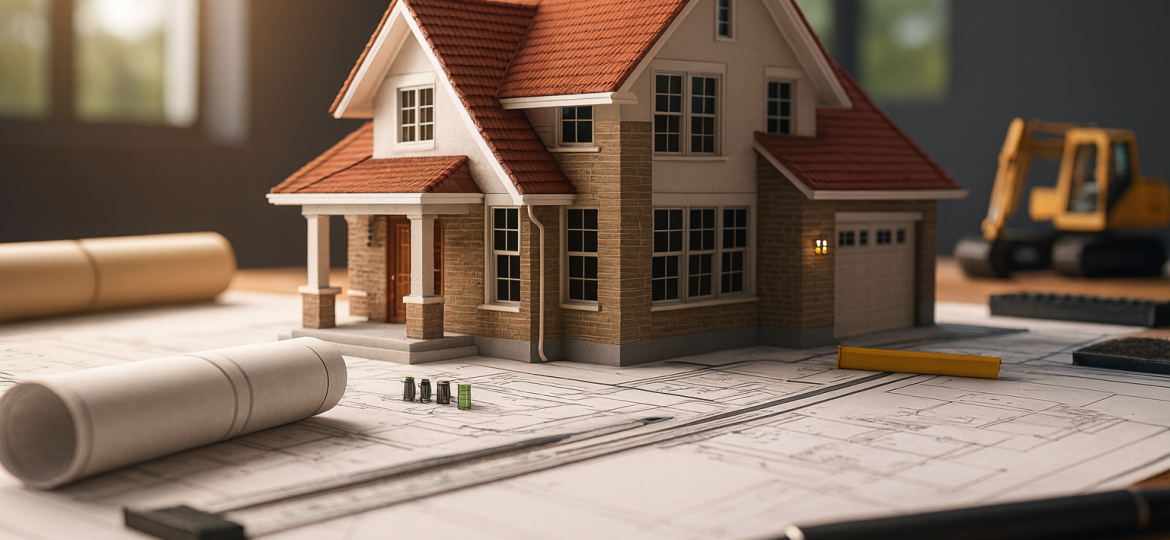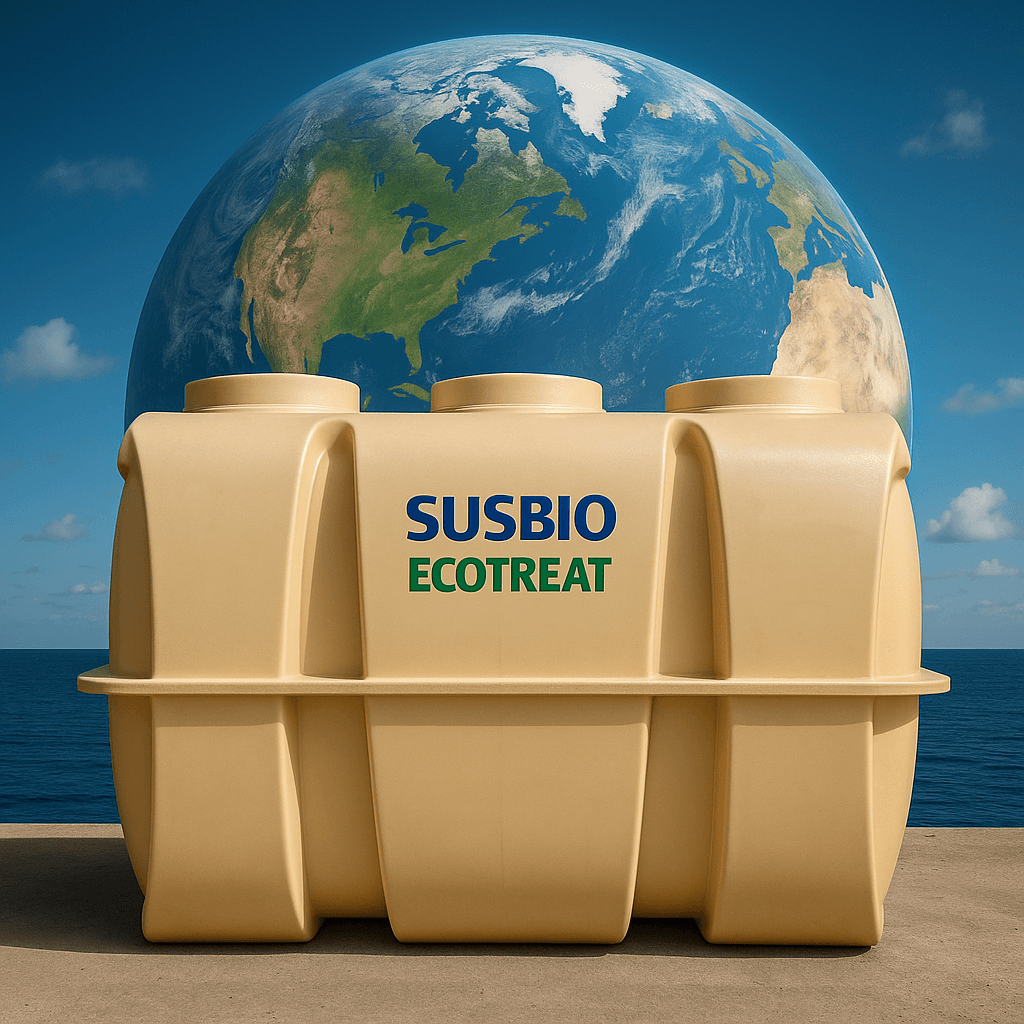A sewage treatment plant (STP) is a facility designed to treat and purify wastewater generated from homes, businesses, and industries. Through a series of physical, biological, and sometimes chemical processes, STPs remove contaminants, solids, and pathogens, producing water that is safe to discharge into the environment or reuse for non-potable purposes. These plants play a crucial role in maintaining public health and protecting our natural water bodies.
The Importance of Sewage Treatment Plants in Modern Living
Environmental Protection: STPs prevent untreated sewage from entering rivers, lakes, and groundwater, safeguarding aquatic life and ecosystems.
Public Health: By eliminating harmful bacteria, viruses, and other pathogens, STPs reduce the risk of waterborne diseases.
Water Conservation: Treated water can be safely reused for irrigation, landscaping, flushing, and industrial processes, reducing the demand on freshwater resources.
Legal Compliance: Proper sewage treatment ensures adherence to environmental regulations and avoids penalties for non-compliance.
Why Choose an Underground Sewage Treatment Plant? Key Benefits Explained
Underground sewage treatment plants (USTPs) are rapidly becoming the preferred solution for modern developments, especially in cities and areas where land is at a premium. Here’s a closer look at the compelling reasons to choose an underground STP for your project:
1. Maximized Space Utilization
In urban environments, every square foot counts. Underground sewage treatment plants are ingeniously designed to fit beneath the surface, freeing up valuable land above for other purposes. This is especially beneficial for:
Residential Complexes: Allows for more green spaces, playgrounds, parking lots, or additional buildings.
Hotels and Resorts: Maintains open landscapes, gardens, and recreational areas for guests.
Commercial Buildings: Maximizes space for business operations, parking, or future expansion.
By moving the treatment process below ground, you can make the most of your property’s potential without sacrificing essential infrastructure.
2. Enhanced Aesthetics
One of the most significant advantages of USTPs is their ability to remain completely out of sight. Traditional above-ground plants can be visually intrusive, with tanks, machinery, and piping disrupting the landscape. In contrast:
No Visual Clutter: The treatment plant is hidden underground, allowing for seamless landscaping, gardens, or paved areas above.
Design Flexibility: Architects and developers have greater freedom to create attractive outdoor spaces without working around bulky equipment.
Ideal for High-End Properties: Luxury residences, resorts, and commercial spaces can maintain a pristine, welcoming appearance.
3. Reduced Odor and Noise
Odor and noise are common concerns with sewage treatment. Underground installation addresses both:
Odor Containment: The earth acts as a natural barrier, trapping unpleasant smells and preventing them from reaching living or working spaces.
Noise Reduction: Operational sounds from pumps and blowers are muffled by the surrounding soil, ensuring a quieter environment.
Better for Sensitive Locations: Ideal for residential neighborhoods, hotels, hospitals, and schools where comfort is a priority.
4. Low Maintenance Requirements
Modern underground STPs are engineered for efficiency and ease of use:
Easy Access Points: Maintenance hatches and inspection ports are strategically placed for quick servicing without major excavation.
Automated Operation: Advanced systems require minimal manual intervention, with automated controls handling most functions.
Reduced Wear and Tear: Underground placement protects equipment from weather, vandalism, and accidental damage, leading to longer service life and fewer repairs.
5. Enhanced Environmental Safety
USTPs offer additional layers of environmental protection:
Protection from External Elements: Being underground shields the system from weather extremes, reducing the risk of leaks or system failures.
Spill Containment: In the unlikely event of a malfunction, containment is easier and less likely to impact the surrounding environment.
Compliance with Regulations: Underground systems often meet or exceed local environmental and safety standards, ensuring responsible wastewater management.
6. No Impact on Property Value
A visible sewage treatment plant can sometimes deter buyers or lower property values due to perceived nuisance or aesthetic concerns. With an underground plant:
Invisible Infrastructure: The system is out of sight and out of mind for residents, guests, or tenants.
Preserved Property Appeal: Landscapes, gardens, and amenities remain uninterrupted, maintaining or even enhancing the property’s market value.
Ideal for Premium Developments: Developers can confidently market their properties as both sustainable and aesthetically pleasing.
Essential Considerations for Installing an Underground Sewage Treatment Plant
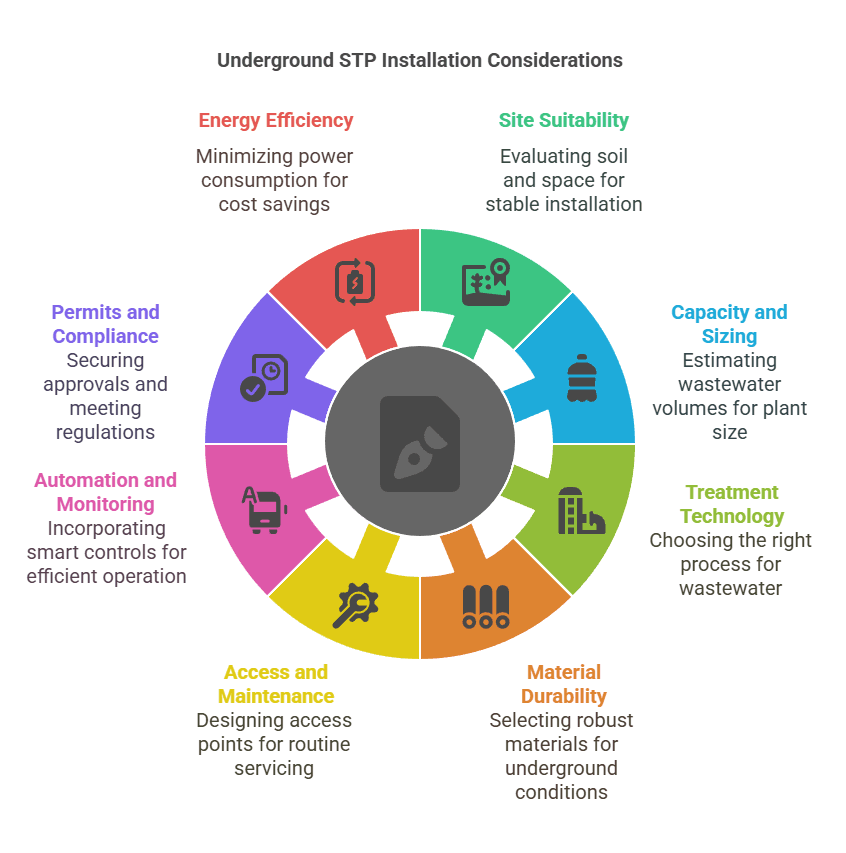
Planning an underground STP installation involves several important factors:
Site Suitability: Assess soil type, groundwater levels, and available space to ensure safe and stable installation.
Capacity and Sizing: Accurately estimate current and future wastewater volumes to select the right plant size.
Treatment Technology: Choose the most suitable process (such as MBBR, SBR, or a hybrid system) based on the nature of the wastewater and regulatory standards.
Material Durability: Opt for robust, corrosion-resistant materials like FRP or reinforced concrete to withstand underground conditions.
Access and Maintenance: Design access points for routine inspection and servicing without disrupting the landscape.
Automation and Monitoring: Incorporate smart controls and sensors for efficient, low-intervention operation.
Permits and Compliance: Secure all necessary approvals and ensure the system meets local environmental and safety regulations.
Energy Efficiency: Select a system that minimizes power consumption to keep operational costs low.
Next-Generation Technologies & Comfort Features in Underground STPs
Underground MBBR & MBR: Compact, Powerful, and Ultra-Clean
Modern underground sewage treatment plants are embracing advanced biological technologies like Moving Bed Biofilm Reactor (MBBR) and Membrane Bioreactor (MBR) to deliver high-performance treatment in the tightest spaces.
MBBR Technology
MBBR systems use floating biofilm carriers, packing a huge treatment capacity into compact tanks. This makes them ideal for underground use where space is limited. MBBR is known for its robust performance, handling shock loads and variable wastewater quality with ease. It also produces less sludge than conventional systems, cutting down on maintenance and disposal costs. With fewer moving parts and self-regulating biofilms, MBBR is a low-maintenance, high-efficiency option for underground installations.
MBR Technology
MBR technology takes treatment a step further by combining biological degradation with membrane filtration. The result is crystal-clear effluent, perfect for water reuse applications like irrigation, toilet flushing, or even cooling towers. MBR’s compact design eliminates the need for large settling tanks, making it a natural fit for underground or modular systems. Its automated operation and resistance to sludge bulking ensure reliable, consistent performance with minimal operator intervention.
Hybrid Solutions
Some underground STPs combine both MBBR and MBR, achieving even higher treatment efficiency, lower membrane fouling, and the ability to handle higher organic loads—all within a small underground footprint.
Odor, Visual, and Comfort Benefits
One of the standout advantages of underground STPs is their ability to disappear from view—and from smell. By placing tanks and equipment below ground, these systems virtually eliminate unpleasant odors, making them ideal for residential complexes, commercial centers, hospitals, and hotels. The earth acts as a natural sound barrier, muffling the noise from pumps and blowers, which is especially important in sensitive environments. With no visible tanks or machinery, the site remains open for landscaping, recreation, or parking, enhancing both aesthetics and land value.
Lifecycle Savings, Smart Integration & Sustainable Advantages
Energy, Emissions, and Maintenance: Underground STPs vs. Traditional Systems
Underground STPs with MBBR or MBR technology are designed for efficiency and sustainability. They use less energy thanks to optimized aeration and stable underground temperatures, which help maintain ideal conditions for biological treatment year-round. Many systems can even recover methane for on-site energy generation, further reducing their carbon footprint. Compared to traditional septic tanks, underground STPs produce less sludge, require less frequent maintenance, and have sealed, corrosion-resistant tanks that last for decades.
Routine maintenance is simplified, often needing just annual servicing. This is a big advantage over septic systems, which require regular pumping and are prone to leaks and failures over time.
Vacuum Sewer Integration & Sewer Mining for Water Reuse
Pairing underground STPs with vacuum sewer systems opens up new possibilities for flat or flood-prone areas. Vacuum sewers use shallow trenches and sealed pipes, preventing leaks and minimizing installation depth. This makes them perfect for urban retrofits and areas with high water tables.
Underground STPs also support the growing trend of sewer mining—extracting and treating wastewater right where it’s generated for immediate reuse. Treated water can be used for irrigation, flushing, or even rooftop farming, dramatically reducing demand for fresh water and supporting a circular economy.
Real-World Inspiration and Regulatory Compliance
Around the world, cities are leading the way with innovative underground STPs. In San Francisco, the Oceanside plant is almost entirely buried beneath hills, preserving the landscape while treating massive volumes of wastewater. In Ireland, the Arklow plant combines gravity flow, solar integration, and architectural excellence to create a sustainable, visually unobtrusive solution.
Underground STPs are a smart choice where land is scarce and environmental regulations are strict. Advanced MBR systems easily meet the toughest discharge standards, and modular or dual-layer designs allow for phased expansion without disturbing the surface. Many systems can even be retrofitted beneath existing parking lots or driveways, offering a “hidden” solution for commercial and residential developments.
Sustainability, Resilience, and the Future
Underground STPs offer stable, year-round operation thanks to the insulating properties of soil, which keeps temperatures ideal for bacterial activity and reduces energy needs. Their sealed, corrosion-resistant tanks are built to last, even in harsh soil conditions, and are less vulnerable to storms, floods, or vandalism. These plants can also support rooftop or urban farming by pumping nutrient-rich effluent to green spaces above, promoting sustainable living and nutrient recycling.
SUSBIO ECOTREAT: The Ideal Solution for Underground Installation
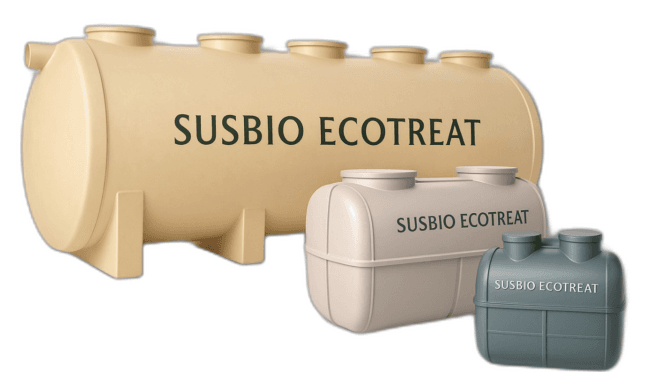
SUSBIO ECOTREAT is engineered for flexible installation, including fully underground setups. Its compact, modular, and prefabricated design allows seamless integration below ground, even beneath landscaped areas or paved surfaces. This makes it an excellent choice for projects where space, aesthetics, and efficiency are paramount.
Real-World Success
SUSBIO ECOTREAT has been successfully installed underground in luxury villa communities and commercial complexes, remaining completely concealed while delivering reliable wastewater treatment.
How SUSBIO ECOTREAT Works: An Overview of the Process
SUSBIO ECOTREAT employs a sophisticated multi-stage process to ensure high-quality treatment:
Preliminary Treatment: Removes large debris and grit to protect downstream equipment.
Primary Treatment: Settles out solids, reducing the organic load.
Secondary Treatment: Uses advanced biological processes like MBBR (Moving Bed Biofilm Reactor) to break down organic matter.
Tertiary Treatment: Provides advanced filtration and disinfection (such as UV treatment) to achieve superior water quality.
Sludge Management: Efficiently manages and minimizes sludge for easy disposal.
Key Features:
Plug-and-Play Installation: Prefabricated modules allow for quick and easy setup.
Fully Automated Operation: Minimal human intervention needed thanks to advanced controls.
Energy Efficiency: Consumes significantly less electricity than conventional systems.
Low Maintenance: Durable construction and automated systems reduce maintenance needs.
Customizable Design: Modular approach allows scaling and adaptation to different site requirements.
Eco-Friendly: Produces high-quality treated water suitable for reuse and reduces environmental impact.
Why SUSBIO ECOTREAT Is the Best Choice for Underground Packaged STPs
Rapid, Trouble-Free Installation: Prefabricated units can be installed quickly, even in challenging or space-limited locations.
Minimal Footprint: Compact design fits perfectly underground, preserving surface space for other uses.
Superior Water Quality: Advanced treatment ensures the output meets or exceeds regulatory standards.
Cost Savings: Lower installation, energy, and maintenance costs compared to traditional systems.
Sustainable and Future-Ready: Efficient operation, low sludge production, and adaptability make it an excellent long-term investment.
Frequently Asked Questions (FAQ)
Can SUSBIO ECOTREAT be used in both residential and commercial projects?
Yes, it is suitable for apartments, villas, hotels, hospitals, resorts, and industrial sites—anywhere efficient, discreet sewage treatment is needed.
How long does installation take?
Thanks to its prefabricated, plug-and-play design, installation can often be completed within a few weeks.
Is maintenance complicated?
No. The system is fully automated and designed for minimal maintenance.
Can the treated water be reused?
Yes. The treated water is suitable for landscaping, toilet flushing, irrigation, and certain industrial processes.
Is SUSBIO ECOTREAT energy efficient?
Absolutely. It uses advanced technology to consume much less electricity than conventional systems.
Is the system scalable and customizable?
Yes, its modular design allows easy scaling and customization to meet specific site needs.
Conclusion: The Smart, Sustainable Future of Wastewater Management
Underground sewage treatment plants are the answer to modern challenges of space, aesthetics, and environmental responsibility. SUSBIO ECOTREAT stands out as the top choice for underground packaged sewage treatment, offering quick installation, low maintenance, high efficiency, and excellent treated water quality. Whether for residential, commercial, or industrial projects, SUSBIO ECOTREAT delivers a sustainable, cost-effective, and future-proof solution—quietly working beneath the surface to keep our communities clean, healthy, and green.


